Click the Services below for more information on each subject.

back
POST-OP 1
Lorem ipsum dolor sit amet, consectetur adipisicing elit. Neque accusamus quod deserunt esse sint amet, non enim consequuntur? Minima officia vitae totam officiis laboriosam suscipit nisi inventore natus quidem eius.

back
POST-OP 2
Lorem ipsum dolor sit amet, consectetur adipisicing elit. Neque accusamus quod deserunt esse sint amet, non enim consequuntur? Minima officia vitae totam officiis laboriosam suscipit nisi inventore natus quidem eius.
Lorem ipsum dolor sit amet, consectetur adipisicing elit. Neque accusamus quod deserunt esse sint amet, non enim consequuntur? Minima officia vitae totam officiis laboriosam suscipit nisi inventore natus quidem eius.

back
POST-OP 3
Lorem ipsum dolor sit amet, consectetur adipisicing elit. Neque accusamus quod deserunt esse sint amet, non enim consequuntur? Minima officia vitae totam officiis laboriosam suscipit nisi inventore natus quidem eius.
Lorem ipsum dolor sit amet, consectetur adipisicing elit. Neque accusamus quod deserunt esse sint amet, non enim consequuntur? Minima officia vitae totam officiis laboriosam suscipit nisi inventore natus quidem eius.
Lorem ipsum dolor sit amet, consectetur adipisicing elit. Neque accusamus quod deserunt esse sint amet, non enim consequuntur? Minima officia vitae totam officiis laboriosam suscipit nisi inventore natus quidem eius.

back
POST-OP 4
Lorem ipsum dolor sit amet, consectetur adipisicing elit. Neque accusamus quod deserunt esse sint amet, non enim consequuntur? Minima officia vitae totam officiis laboriosam suscipit nisi inventore natus quidem eius.
Lorem ipsum dolor sit amet, consectetur adipisicing elit. Neque accusamus quod deserunt esse sint amet, non enim consequuntur? Minima officia vitae totam officiis laboriosam suscipit nisi inventore natus quidem eius.
Lorem ipsum dolor sit amet, consectetur adipisicing elit. Neque accusamus quod deserunt esse sint amet, non enim consequuntur? Minima officia vitae totam officiis laboriosam suscipit nisi inventore natus quidem eius.
Lorem ipsum dolor sit amet, consectetur adipisicing elit. Neque accusamus quod deserunt esse sint amet, non enim consequuntur? Minima officia vitae totam officiis laboriosam suscipit nisi inventore natus quidem eius.

back
BONDING
Bonding is a conservative way to repair slightly-chipped, discolored or crooked teeth. During dental bonding, we place a white filling on your tooth to improve its appearance. The filling "bonds" with your teeth, and because it comes in a variety of tooth-colored shades, it closely matches the appearance of your natural teeth.
Bonding can also be used in place of regular amalgam fillings. Many patients prefer bonded fillings, because the white color is much less noticeable than the silver of the amalgam fillings. Bonded fillings can be used on front and back teeth, depending on the location and extent of tooth decay.
Bonding can usually be completed in one visit to our office. However, bonding can stain and breaks more easily than other cosmetic treatments like porcelain veneers.
If your bonding does break or chip, please let us know. We can generally patch or repair bonding in one visit.

back
COSMETIC SERVICES
We are as dedicated to your confidence in your smile as we are to your lasting oral health. You deserve to look and feel your best!
With today’s rapid advances in dental techniques and technologies, a variety of cosmetic services are becoming more affordable and readily available to you. It may be easier than you think to achieve that brilliant smile you’ve always wanted.
A cosmetic dental practice is a practice trained in many different specialties, including areas like prosthodontics, periodontics and orthodontics, among others. We stay up to date on the best cosmetic dentistry available to deliver your best look. Our skilled team has in-depth training to provide you a variety of cosmetic options. Services include:
Learn More

back
CROWNS AND BRIDGES
Crowns and bridges are used to restore and enhance teeth that are damaged, or to replace missing teeth. A crown, also called a cap, is used to entirely cover a damaged tooth. A crown not only strengthens a tooth, but it can also dramatically improve a tooth's appearance, shape and alignment.
Crowns may be used to:
- Replace a large filling when there is little tooth structure remaining
- Protect a weak tooth from fracturing
- Restore a fractured tooth
- Attach a bridge
- Cover a dental implant
- Cover a discolored or poorly-shaped tooth
- Cover a tooth that has had root canal treatment
A bridge is an ideal method to fill the space created by missing teeth. A bridge is one or more artificial teeth that are cemented in place using the real teeth on either side for support--hence the name. This is an option for filling the space created by a missing tooth. A bridge replaces the missing tooth, both functionally and cosmetically. Bridge work is as much an art as it is an exact science. Bridge materials include gold alloys, porcelain bonded to metal alloy, or all-ceramic material made to match your natural tooth color. The choice of material depends on requirements for strength, wear, and/or esthetics.

back
DENTAL PROPHYLAXIS
A dental prophylaxis is a professional cleaning you receive from a dentist or dental hygienist. Cleanings should be performed every six months to prevent excessive plaque buildup. Plaque left untreated can lead to unhealthy gums and tooth decay. A routine dental cleaning should include scaling, root planing and polishing.
Scaling and root planingis the process of removing plaque and tartar from all tooth surfaces with a variety of methods, depending on the amount of plaque and tartar. Dental hygienists traditionally perform scaling by hand. However, new and advanced technology has led to more modern methods such as ultrasonic scalers. This sophisticated tool allows dental cleanings to be performed more efficiently and in less time. Both ultrasonic and manual scaling methods can be combined to achieve the best results. Polishing completes the cleaning, making the surface of the teeth smooth and minimizing future plaque build-up.
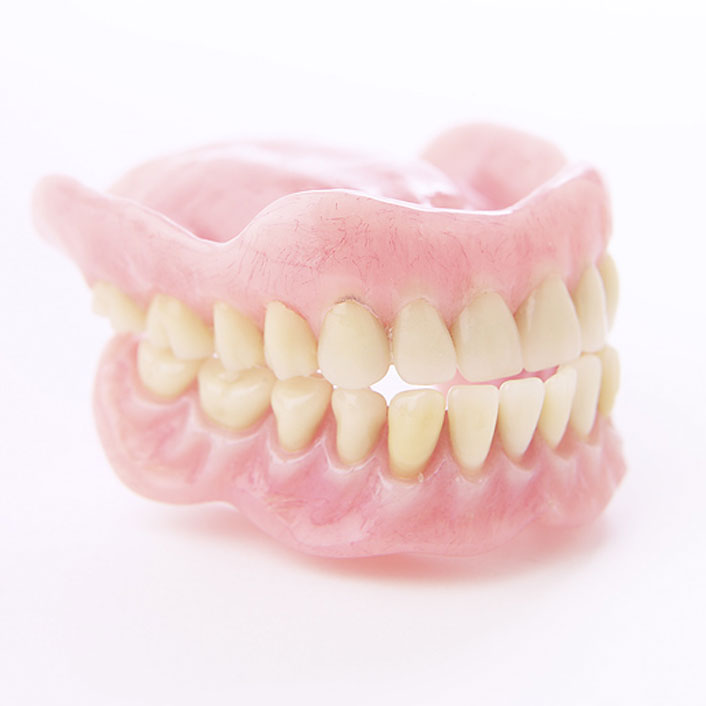
back
COMPLETE DENTURES & PARTIALS
A denture is a removable replacement for missing teeth and surrounding tissues. There are two types of dentures available: partial dentures and complete dentures. Partial dentures are used when some natural teeth remain and complete dentures are used to replace all teeth. Dentures are made to resemble your natural teeth so there should be no noticeable change to appearance. In fact, dentures may even improve a smile!
Complete Dentures – This restoration method is used to restore smile and mouth function if all teeth have been lost. The dentures are custom-created to resemble natural teeth and are positioned into a patient's mouth to take the place of where the natural teeth used to be. Complete dentures are removable and may require adjustments in order to create a proper fit with the gums and mouth.
Partial Dentures – A removable partial denture is used when one or more natural teeth still remain in the upper or lower jaw. They usually consist of replacement teeth attached to a gum-colored plastic base that is held in place in the mouth. A fixed partial denture is similar to a removable denture, but it is cemented into place using the adjacent teeth for support. This fills the space created by missing teeth and creates a support for remaining teeth in order to prevent shifting.
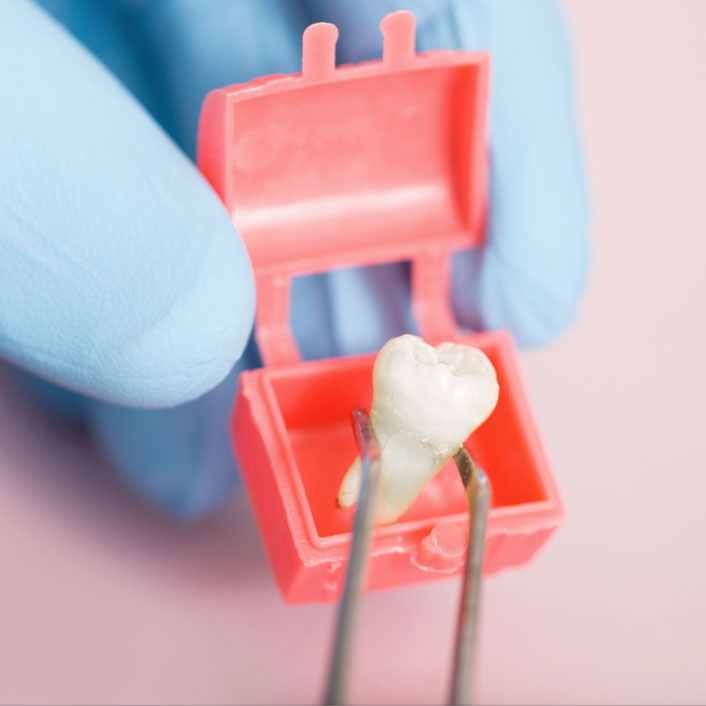
back
EXTRACTIONS
Good oral hygiene is a must, because the loss of a single tooth can have major impact on overall oral health and appearance. Although dentists will use every measure to prevent tooth loss, there are still some occasions when a tooth needs to be extracted. A tooth may need to be extracted if the following occurs:
- Severe decay
- Advanced periodontal disease
- Infection or abscess
- Orthodontic correction
- Malpositioned teeth
- Fractured teeth or roots
- Impacted teeth
The dentist may advise to have a tooth extracted after careful examination and treatment—often taking x-rays to understand the shape and position of the tooth and surrounding bone before extracting the tooth. Based on the degree of difficulty, a dentist may refer you to a specialist called an oral surgeon.
A certain amount of pain and discomfort is to be expected following an extraction, but it can be minimized with pain killers and ice packs applied to the face for 15 minutes at a time. Discomfort should lessen within three days to two weeks.
If you experience prolonged or severe pain, swelling, bleeding or fever, call our office immediately.

back
FILLINGS
A filling is a way to restore a tooth damaged by decay back to its normal function and shape. If you have a tooth that requires a filling, the dentist will first remove the decayed tooth material, clean the affected area, and fill the cleaned-out cavity with a filling material. This filling will help prevent further decay by closing off any cracks or spaces where bacteria might enter.
There are a variety of filling materials available including gold, silver, plastic and porcelain. We will work with you to determine which material is best for you, depending on the extent of repair, where in your mouth the filling is needed, and the cost. Each of the filling materials is briefly explained below:
- Gold fillings are custom-made in a laboratory and then cemented into place. While gold fillings are often the most expensive choice, many consider gold as the best filling material. Gold inlays are well-tolerated by gum tissues and may last more than 20 years.
- Amalgam (silver) fillings are a more inexpensive choice and are also well-tolerated. However, due to their dark color, they are more noticeable than porcelain or composite restorations and are not recommended for fillings in very visible areas such as front teeth.
- Composite (plastic) resins are custom-made to the exact color of the patient's teeth, creating a more natural appearance. While these white fillings may be less noticeable than other materials, they usually only last between 3 and 10 years. They may not be ideal for large fillings as they may chip or wear over time. They can also become stained from coffee, tea or tobacco.
- Porcelain fillings are created in a lab and then bonded to the tooth. They can be matched to the color of the tooth, resist staining, and are about the same cost as gold fillings. A porcelain restoration generally covers most of the tooth, making the filling nearly undetectable.

back
HALITOSIS TREATMENT
Halitosis is the sophisticated word for "bad breath". Depending on the cause, bad breath may happen only occasionally or may be a more persistent condition. The most common cause of bad breath is bacteria. Because the mouth is moist and warm, it creates perfect conditions for the millions of bacteria that live in the mouth. In fact, approximately 80% of bad breath is caused by something in the mouth.
Bad breath caused by bacteria in the mouth can be easily treated. Brushing your teeth, tongue and gums after meals as well as flossing and rinsing with mouthwash will usually take care of the problem. Regular visits to our office for a deeper, professional cleaning and exam will also help you.
Most types of occasional bad breath, such as "morning mouth," are considered fairly normal and are not usually health concerns. However, persistent bad breath may be a sign of more serious problems with the gums and teeth.
Bad breath may be caused by the following:
- Poor oral hygiene, which can leave food particles to decay in the mouth
- Infections in the mouth such as periodontal (gum) disease
- Respiratory tract infections such as throat infections, sinus infections or lung infections
- External agents including foods such as garlic, onions, and coffee, as well as cigarettes and chewing tobacco
- Dry mouth caused by salivary gland problems or by breathing through the mouth
- Systemic illnesses such as diabetes, acid-reflux disease, liver disease, kidney disease, lung disease, sinus problems and others
In treating bad breath, the dentists will perform a physical examination of the patient's mouth to determine the cause. If they discover that systemic problems are the cause, they may refer the patient to their family physician. In severe cases of gum disease, it is recommended that a patient visit a periodontist, a doctor that specializes in treating gum disease.
Call our office promptly if you have bad breath with painful, swollen gums that bleed easily or loose teeth.

back
PERIODONTAL (GUM) TREATMENT
The gums, ligaments, and bone around the teeth form the foundation for one's teeth. All structures are also referred to as the periodontium. When the periodontium is not healthy, it jeopardizes the teeth just as a bad foundation would threaten the stability of a house. Signs of unhealthy periodontium include: gums that are red and bleed easily, persistent bad breath, gums that are pulled away from the tooth, loose teeth, and changes in the position or bite of the teeth. Any of these may be a sign of a problem. With proper gum treatments, however, it may be possible to return gum tissue to a healthy state. If you're having a problem, come in and see us so we may treat it right away. The treatment usually involves a deep cleaning or root planing done under a local anesthetic, along with local antibiotic agents. If the gum disease gets too severe it may need to be treated through surgery or extraction. This is why it is important to have it treated at the first sign of a problem.

back
IMPLANT RESTORATION
A dental implant is an ideal tooth restoration for people who are missing one or more teeth for a variety of reasons like injury or periodontal disease. To begin the implant process, a metal post is surgically positioned into the jaw. Once it is in place and the bone surrounding the implant has had time to heal, a replacement tooth is attached to the post. While implants are typically more expensive than other methods of tooth replacement, they provide superior benefits. Implants are stronger than natural teeth and generally last 10-20 years. They are also a more favorable approach than bridgework, because they do not depend on neighboring teeth for support.
Implants require healthy gums and adequate bone. A patient must also be committed to excellent oral hygiene and regular dental visits, as these are critical to the long-term success of dental implants.

back
INVISALIGN
Invisalign is an attractive alternative to traditional metal braces. It is a series of clear, custom-fit removable mouth trays that apply a controlled amount of force to your teeth, slowly straightening them. The system provides the same beautiful results as traditional braces, but they are virtually invisible. Because Invisalign trays are removable, they can be taken out while eating, drinking, brushing and flossing.
The Invisalign system begins in the dentist or orthodontist's office with taking molds to design a patient's trays. Patients switch trays every two weeks, slowly shifting the teeth. The system requires a visit to the office every six weeks so the treatment can be monitored. Once treatment is complete, a patient will likely be given a retainer to maintain the smile.
The cost of Invisalign varies according to the complexity of the case. However, Invisalign is generally more expensive than traditional braces. Insurance policies generally cover Invisalign to the same extent that they cover traditional braces.

back
LUMINEERS
Veneers are a common cosmetic procedure in which the outside of the tooth is covered, improving the appearance. LUMINEERS® BY DenMat are a special kind of porcelain veneers that offer a painless way to a permanently whiter and perfectly-aligned smile. These "smile shapers" are as thin as contact lenses and can be applied to your teeth without any grinding or shaving. They create a beautiful and natural-looking smile. LUMINEERS can even be placed over existing crown or bridgework without having to replace them.
Our team has taken numerous advanced training courses in this procedure. To see if you are a candidate, call our office for a consultation.
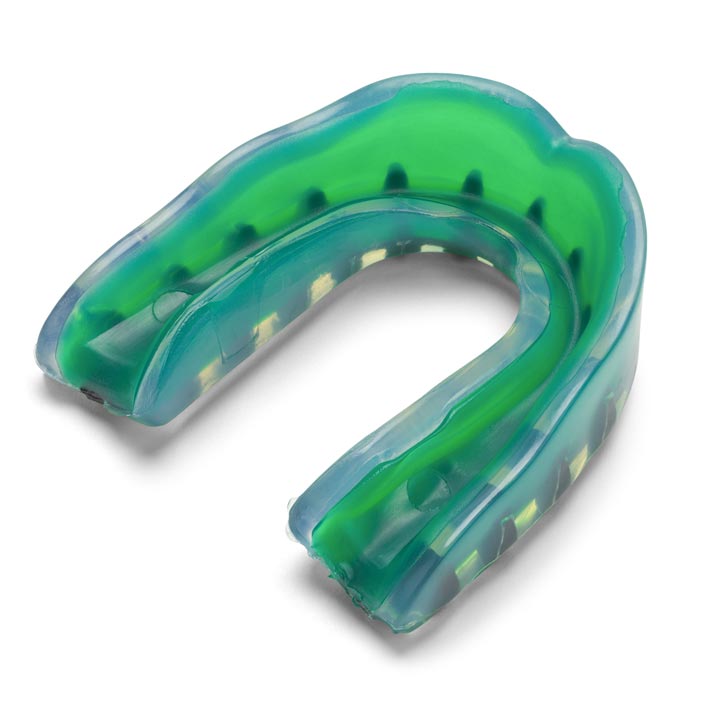
back
NIGHTGUARDS / MOUTHGUARDS
Custom-designed mouthguards and nightguards are made of flexible plastic and molded to fit the shape of your teeth. Mouthguards are recommended to protect the jaw , tongue, cheek lining and teeth during physical activity and sports such as boxing, football, basketball, or other activities where your mouth might get hit. Nightguards are recommended for patients who clench or grind their teeth at night to protect their teeth. Guards generally last 3-10 years.
If you have decided a guard is right for you, we will take an impression of your teeth that will be sent to a lab to make a custom-fit guard for you.

back
ORAL HYGIENE MAINTENANCE
Maintaining good oral hygiene is one of the most important things a patient can do for their teeth and gums. It's ultimately up to the patient in between visits, but the dentist is here to help and offer tips. Healthy teeth enable patients to have a smile that is both attractive and functional, and good oral health is vitally important to overall well-being.
Daily preventive care in between regular dental visits can greatly decrease the risk of developing tooth decay, gum disease and other dental problems. Consider incorporating these habits:
- Brush thoroughly twice a day and floss daily
- Eat a balanced diet and limit snacks between meals
- Use dental products that contain fluoride, including fluoride toothpaste
- Rinse with a fluoride mouth rinse if your dentist advises you to
- Make sure that your children under 12 drink fluoridated water or take a fluoride supplement if they live in a non-fluoridated area
Feel free during your visit to our office to ask us any questions regarding your oral hygiene habits. We are here to help you.
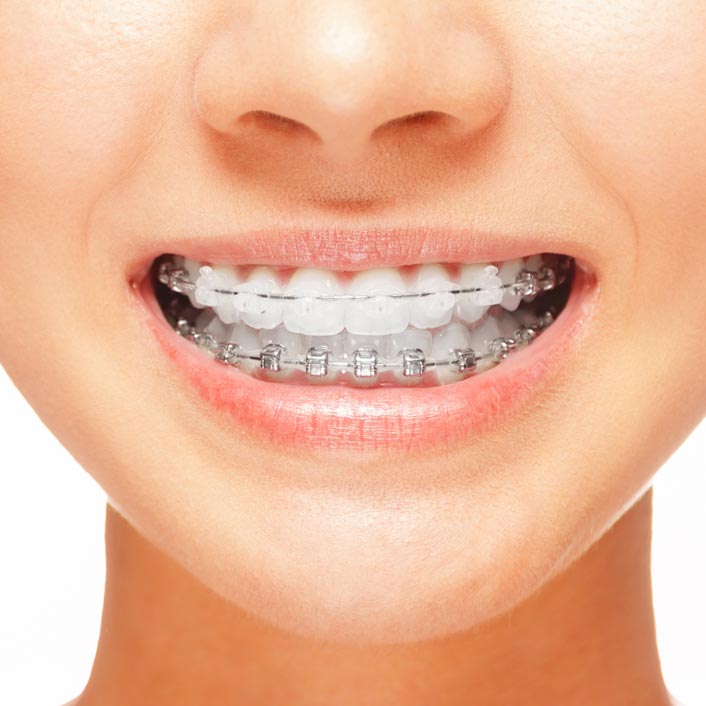
back
ORTHODONTICS
Orthodontics is the art of using special appliances to straighten and align the teeth and bite. Braces are the most common orthodontic treatment. In this method, arch wires are threaded through brackets that are bonded to the surface of the teeth. The arch wires act as a track, and guide each tooth to its proper position. There are several types of orthodontic braces available, including the more traditional metal braces, ceramic "tooth colored" braces, as well as clear plastic braces.

back
ROOT CANALS
Root canal treatment, also referred to as root canal therapy or endodontic therapy, is used to save an infected or damaged tooth and avoid having to remove it. A root canal becomes necessary when a neglected cavity reaches all the way to the pulp at the center of the tooth and becomes infected. Regular cleanings and checkups detect and prevent problems early on. Trauma can also cause the nerve of a tooth to be deeply damaged. Once this occurs, the pulp becomes infected, even extending through the root tip, and it begins to eat away at the surrounding bone (this is called an abscess). By the time the pulp is infected it must be treated, and cannot heal on its own. It can even weaken the entire immune system, making it very dangerous and painful. Symptoms of infected pulp may include sensitivity to hot/cold or sweets, pain, swelling, pain with biting or pressure, and a bad taste in the mouth. Sometimes, however, there are no symptoms, and you are unaware of any problem until a checkup.
A root canal is performed to clean out the infected tooth pulp and disinfect the canals of the tooth. The only other treatment would be to extract the tooth. Once the infection is resolved, the canal(s) is filled to prevent any further infection. Crowns are usually recommended to cover and restore a tooth after root canal therapy.
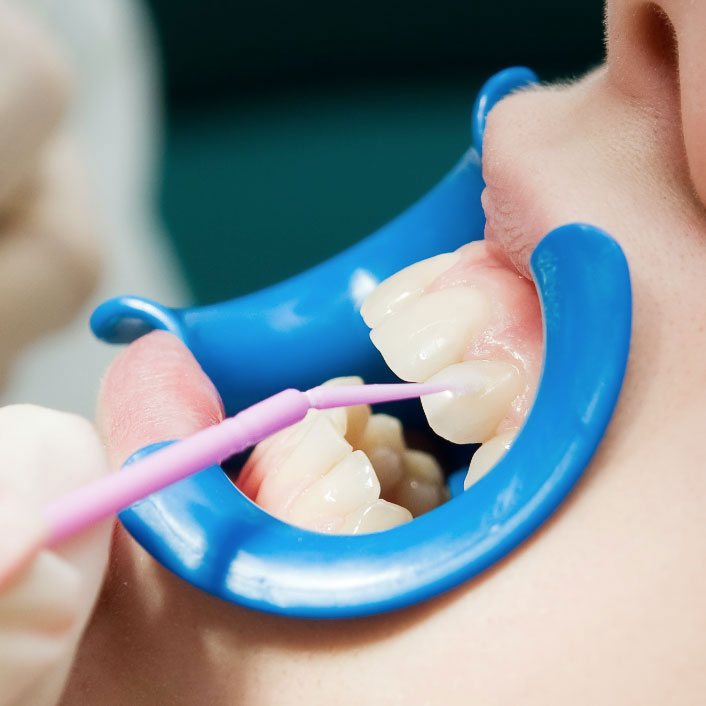
back
SEALANTS
Sealants are a common preventive treatment in dentistry. Some teeth have fine grooves or pits that accumulate plaque, not because the person doesn't brush, but because the grooves are too narrow to allow even one bristle into them. When plaque accumulates, it can lead to cavities and other types of tooth decay. To apply sealants, a plastic material is brushed onto the tooth, filling these narrow grooves and preventing the cavity-causing buildup. Sealants make healthy teeth possible.

back
NITROUS SEDATION FOR DENTAL ANXIETY
Dental sedation is a technique that can be used when a patient suffers from dental anxiety or dental phobia. We are happy to offer a number of solutions for our patients to make their dental visit as comfortable as possible. Sedation dentistry techniques enable patients - who might otherwise avoid the dentist - to receive dental treatment necessary for a healthy smile.
Depending on the extent of the anxiety or phobia, varying degrees of dental sedation can be utilized as described below.
Nitrous Oxide Sedation
Nitrous Oxide sedation, also known as "laughing gas" is commonly used to make treatment more comfortable. This sedation is inhaled through a mask that allows you to breathe in the medication and induces a state of relaxation. Local anesthetic will be administered in conjunction with nitrous oxide to eliminate pain.

back
SLEEP APNEA TREATMENT
Problems with sleep can quickly and negatively impact overall well-being. High blood pressure, heart disease, stroke, brain damage, depression, erectile dysfunction, diabetes, weight gain and more—all of these can be caused by sleep apnea and snoring. Solve your sleeping struggles at the dentist's office? It's definitely possible.
Oral sleep appliance therapy can be a very effective treatment option for patients suffering from mild to moderate obstructive sleep apnea. These custom-fit appliances shift the lower jaw forward and open the bite and airway.
Following are some common symptoms of sleep breathing disorders:
- Daytime drowsiness or fatigue
- Loud, recurring snoring
- Choking or gasping for air in your sleep
- A man with neck size greater than 17 inches
- A woman with neck size greater than 16 inches
- Stop breathing while asleep
- Unexplained weight gain/trouble losing weight
- High blood pressure
- Acid reflux
- History of stroke or heart attack
- Fall asleep during the day when activity is low
- Family history of sleep apnea
- Impotence
If you suffer from any of these symptoms, come into our office for a consultation. We will review the severity of your condition and discuss dental sleep treatment. It is always best to have had a sleep study conducted to determine the severity of your problem. However, this may not be necessary in treatment for simple snoring.
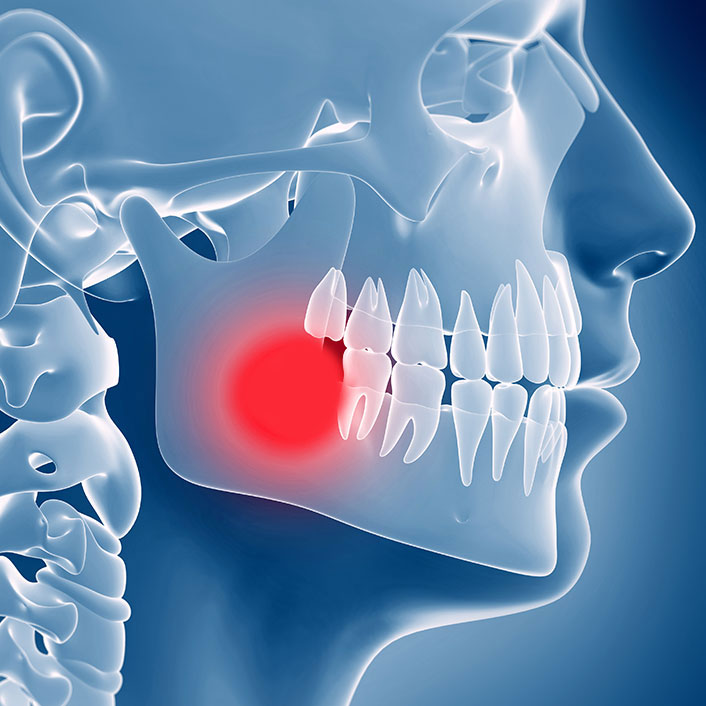
back
TMJ TREATMENTS
TMJ stands for temporomandibular joint and is used to describe dysfunction or disorders related to the joint. "Temporo," refers to the temple area of the skull; "mandibular," refers to the lower jaw; and "joint" is essentially where the head and jaw meet. Problems in this joint may be caused by a trauma, misalignment of the teeth, or excess muscle tension. The two bones that meet at the jaw are buffered by cartilage and five different muscles, so TMJ can cause a variety of troubles.
Common TMJ symptoms:
- Headaches
- Earaches
- Trouble/soreness in opening and closing the mouth
- Clicking or popping of the jaw
- Pain in the jaw muscles
- Soreness in the area, sometimes extending to the face
Dental treatments for the condition can include replacing missing teeth, moving teeth, adjusting the bite, filling gaps between teeth, and more. There is no one solution that is right for all cases. Sometimes a plastic mouthpiece is used to prevent clenching or grinding that is contributing to the problem. If TMJ is left untreated and reaches extremes, surgery may be required to repair the badly damaged joint.

back
VENEERS
Veneers are a cosmetic dental procedure in which a thin layer of porcelain or composite material is placed over the outside of the tooth. They are used to improve esthetics or help with tooth damage. Veneers are usually only done to the part of the teeth that are visible when talking or smiling. The procedure can be direct or indirect.
The direct technique usually involves placing composite resin on the outside of the tooth using bonding. Because of that, the direct technique is usually referred to as bonding.
The indirect technique usually involves two appointments because the veneers are fabricated at a dental laboratory. At the first appointment the teeth are prepared, impressions are taken, and the teeth are given a temporary covering. The veneers are back from the laboratory after two or three weeks. The temporaries are removed, and the veneers are bonded to the teeth.The laboratory-fabricated veneers are usually made using porcelain or pressed ceramic, and are esthetically pleasing.
The advantage of veneers versus crowns is that much less of the tooth material has to be removed, and the procedure is generally less uncomfortable. Veneers are recommended for patients who have large fillings or little tooth structure.
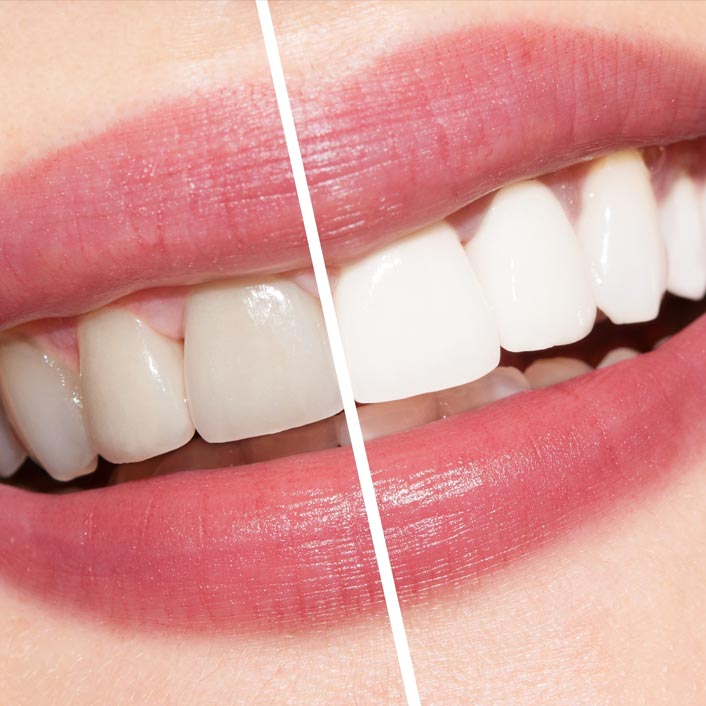
back
WHITENING
Teeth whitening is a popular procedure to make your teeth whiter and brighter, and therefore more attractive. Bleaching can be used to whiten stained and discolored teeth, or simply to enhance a dull smile. Either way, tooth whitening is a safe and relatively painless procedure for most patients. Our office offers two methods of whitening: in-office whitening and tray whitening.
E-Z White is a common in-office whitening procedure and is ideal if you want immediate results. The whole process takes about an hour, taking little time out of busy lives. A protective gel is applied to your gums to protect the soft tissue. Then a special light-activated gel is applied to your teeth and light or laser is used to enhance the action of the agent. Finally, the patient receives a take-home pen and instructions to keep the smile bright. The result is dramatically whiter teeth that will last for years.
Tray whitening is a convenient at-home whitening treatment. The results are more gradual. An impression is taken at the dentist's office in order to create a customized clear tray. Trays are generally ready within a few days, depending, and the patient must follow instructions for how to apply the gel in the trays and how often to use it. Maximum whitening results and a dazzling smile are achieved at the end of the set treatment period. An occasional treatment can be used to maintain the new smile.
Please consult us about use of over-the-counter whitening treatments.
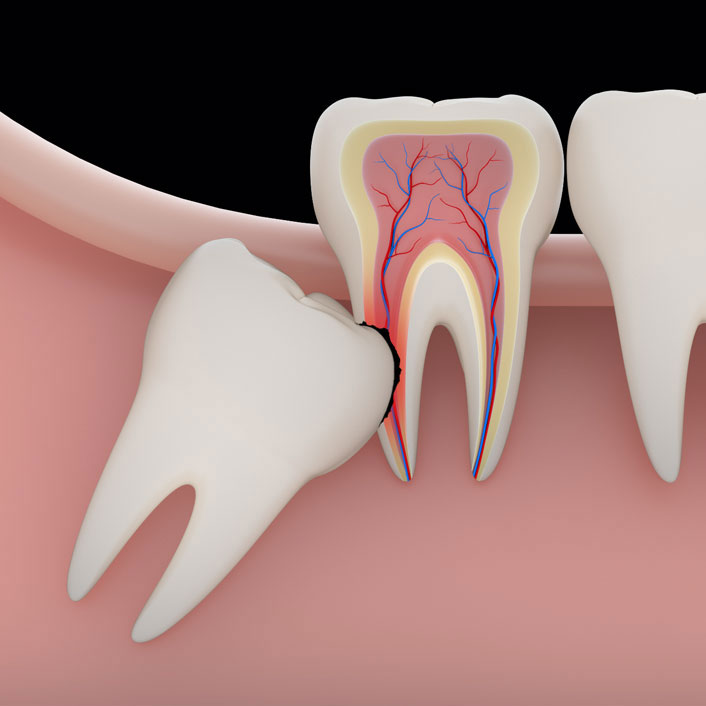
back
WISDOM TOOTH EXTRACTIONS
Wisdom teeth are the last molars, or "third molars" that develop on each side of the jaw. They usually emerge in the back of the mouth between the ages of 16-20.
Wisdom teeth are a valuable asset to the mouth when they are healthy and properly positioned. Often, however, they cause problems and require removal. When the jaw isn't large enough to accommodate wisdom teeth, they can become impacted. Impacted wisdom teeth may grow sideways, emerge only part way through the gum or remain trapped beneath the gum and bone.
A wisdom tooth extraction is a relatively routine procedure. The dentist will numb the area in the mouth with a local anesthesia or use IV sedation so that the patient is asleep during the procedure.
After the tooth (or teeth) is removed, the patient is given gauze and bites down softly for a recommended amount of time to limit any bleeding. Some pain and swelling may occur, but it will usually go away after a few days.
Please call our office if, after following post-op instructions, you have prolonged or severe pain, swelling, bleeding or fever.

back
JUVÉDERM
Wait a minute—you can get Juvéderm at the dentist’s office? Yes you can! Dentists already have extensive knowledge in facial muscles and tissues. Additionally, dentists in any speciality are often particularly skilled in delivering virtually painless injections.
Juvéderm is also an FDA-approved cosmetic procedure, but works differently from BOTOX in that it is a dermal filler. The filler substance is made up of mostly hyaluronic acid (HA), which is a sugar that occurs naturally in the body. As we age, the amount of HA in facial skin and muscles decreases, causing breakdown and wrinkles. The Juvéderm injection literally fills and facial wrinkles and folds, especially around the nose and mouth, by adding volume to the skin and smoothing it out. It thereby restores a more youthful appearance. Juvéderm can also be used as a lip filler. The results can last anywhere from three months to as much as a year, depending on multiple factors.
Juvéderm is a prescribed cosmetic therapy and is not for everyone. Ask us for more information about our facial cosmetic services and how we can incorporate them into your office visits. We will work together to establish the best treatment plan for you.

back
BOTOX
Can dentists offer BOTOX? The answer is a definite yes! Dentists already have extensive knowledge in facial muscles and tissues. Additionally, dentists in any speciality are often particularly skilled in delivering virtually painless injections.
BOTOX Cosmetic is an FDA-approved prescription medicine that is injected into various points in facial muscles to smooth wrinkles and improve appearance. BOTOX works by blocking signals from nerves to the muscles so that the muscles can no longer contract. This relaxes and softens wrinkles. Imagine getting rid of frown lines or crow’s feet during your dental visit! BOTOX results are not permanent. They typically last four to six months. The treatment requires periodic visits in order to maintain the smooth appearance.
BOTOX is prescribed cosmetic therapy and is not for everyone. Ask us for more information about our facial cosmetic services and how we can incorporate them into your office visits. We will work together to establish the best treatment plan for you.
Click the Technologies below for more information on each subject.

back
Patient Education
You deserve to be in the loop when it comes to your dental care. There are a variety of computer programs available to help patients better understand conditions, procedures and treatment options. Our office invests in patient education software because we want you to feel confident in every dental decision you make. This investment helps us clearly communicate--and it helps you learn more.
Popular programs include GURU and DentalMaster, among many others. If you have any questions about the program we use, we're happy to point you to the website. If you have any further questions about your oral health and procedures, don't hesitate to ask us.

back
Oral Cancer Screening
Oral cancer is one of the most common cancers today and has one of the lowest survival rates, with thousands of new cases being reported each year. Fewer than half of all people diagnosed with oral cancer are ever cured.
Moreover, people with many forms of cancer can develop complications-some of them chronic and painful-from their cancer treatment. These include dry mouth and overly sensitive teeth, as well as accelerated tooth decay.
If oral cancer is not treated in time, it could spread to other facial and neck tissues, leading to disfigurement and pain.
Older adults over the age of 40 (especially men) are most susceptible to developing oral cancer, but people of all ages are at risk.
Oral cancer can occur anywhere in the mouth, but the tongue appears to be the most common location. Other oral structures could include the lips, gums and other soft palate tissues in the mouth.
Warning Signs
In general, early signs of oral cancer usually occur in the form of lumps, patchy areas and lesions, or breaks, in the tissues of the mouth. In many cases, these abnormalities are not painful in the early stages, making even self-diagnosis difficult.
Here are some additional warning signs:
- Hoarseness or difficulty swallowing.
- Unusual bleeding or persistent sores in the mouth that won't heal.
- Lumps or growths in other nearby areas, such as the throat or neck.
If a tumor is found, surgery will generally be required to remove it. Some facial disfigurement could also result.
Prevention
Prevention is the key to staving off oral cancer. One of the biggest culprits is tobacco and alcohol use. Certain kinds of foods and even overexposure to the sun have also been linked to oral cancer. Some experts believe certain oral cancer risk factors are also hereditary.
A diet rich in fruits and vegetables is one of the best defenses against oral cancer. Maintaining good oral hygiene, and regular dental checkups, are highly recommended.
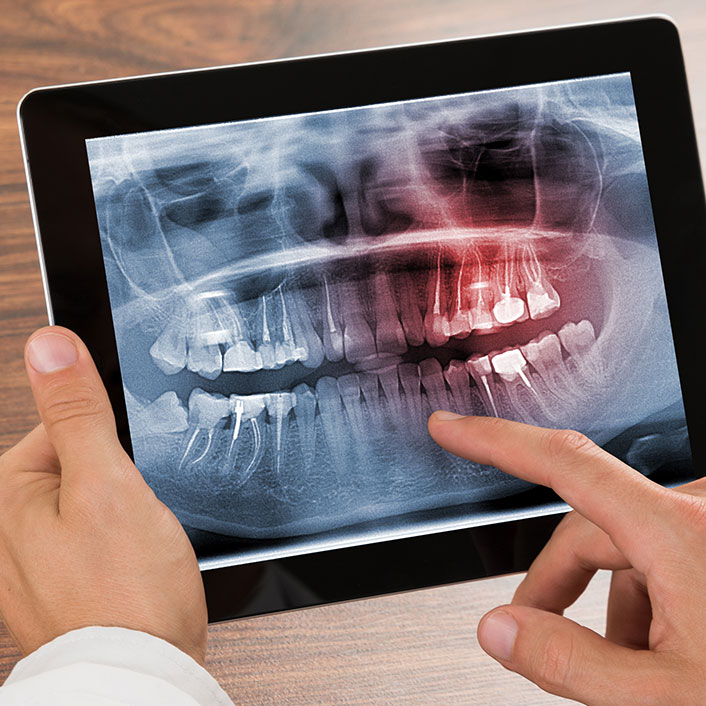
back
X-RAYS AND DIGITAL X-RAYS
X-rays are a focused beam of x-ray particles passed through bone which produce an image on special film, showing the structure through which it passed. This provides the familiar black and white images doctors and dentists use to diagnose problems and disease. Without an x-ray of the whole tooth and supporting bone and gum tissues, there would be no way to detect infection or pathology that requires attention.
In our office we use digital radiography which allows us to take x-rays using up to 90% less radiation than conventional film x-rays. Using this technology, we are able to take an x-ray of your mouth by using a small sensor which records the image of your teeth and sends it to a computer. The result is a highly detailed image of your mouth that can easily be enhanced to better diagnose dental concerns and determine the very best treatment for each case.
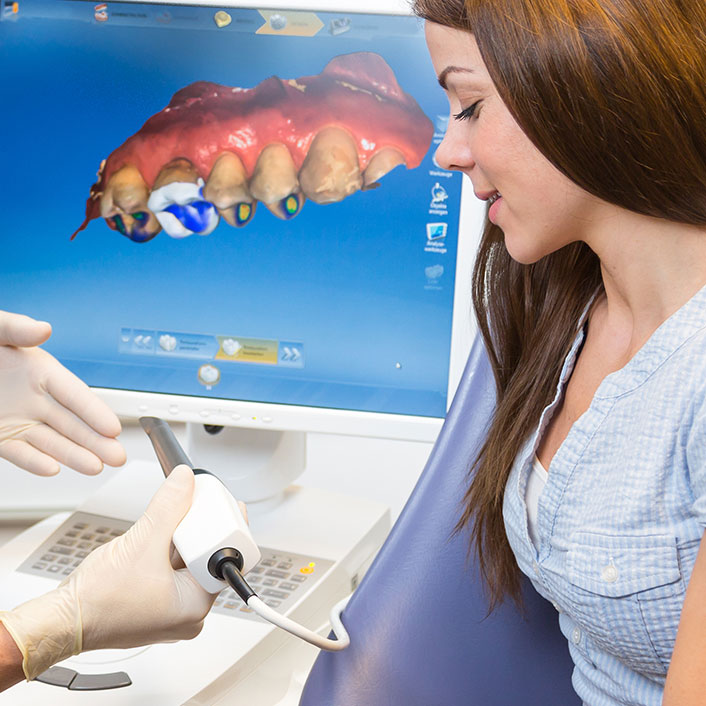
back
DIGITAL IMAGING
We use digital imaging software in our office, which allows us to take a digital picture of you and use our imaging system to predict how a particular treatment or cosmetic procedure would change the appearance of your teeth. This software is beneficial for patients who are considering cosmetic procedures but are not sure if they're ready for dramatic changes. Digital imaging also allows us to document your dental case and procedures very well. We take digital images of your face, teeth and smile to provide us with a permanent dental record and to provide a visual documentation of treatment.

back
ELECTRONIC CLAIMS
Our office utilizes electronic claims processing. This means that rather than sending your dental claim through the mail, it is sent electronically to your insurance company with the click of the button. By filing your claim electronically, information is submitted more efficiently and with fewer errors. This benefits our patients because the turn around time on claims is faster and fewer claims are returned or denied. We are happy to submit your dental claims to your insurance company on your behalf.

back
TELESCOPIC LOUPES
The dentist performs most of his dental procedures while wearing a pair of funny looking glasses called surgical telescopes. These powerful glasses have magnifiers on them, allowing the dentist to see fine details that would go unnoticed to the naked eye.

back
INTRAORAL CAMERA
We use small cameras about the size of a pen, called intraoral cameras, to help clearly see the condition of your teeth and gums.
With this advanced technology we can zoom in on small diseased areas, cracks, chips and worn metal fillings with extreme precision. The full-color images taken with the intraoral camera are sent to a computer screen so we can clearly see and diagnose dental problems much earlier than with traditional dental technology. Because images are displayed on our screens, patients will also be able to see areas being worked on and are able to gain a better understanding of dental procedures being performed.

back
PAPERLESS CHARTING
Our office is a completely digital (paperless) dental office. This means all x-rays and charting are made and recorded with the aid of the computer. This technology allows us to maintain your dental records electronically, and cuts down the unnecessary paperwork used with traditional paper charting. Traditional paper charting is difficult to keep standardized from doctor to hygienist to assistant. Even handwriting differences and coding make the charts look different. The computer eliminates this problem by using consistent charting methods that are accurate and precise, making it easy to read your dental chart and see up-to-date information. Digital charting standardizes the charting process so it is clear, easy to understand, and enables us to provide on the most accurate and precise care to our patients. When needed, this method also allows us to quickly and securely share information with your other health care providers.
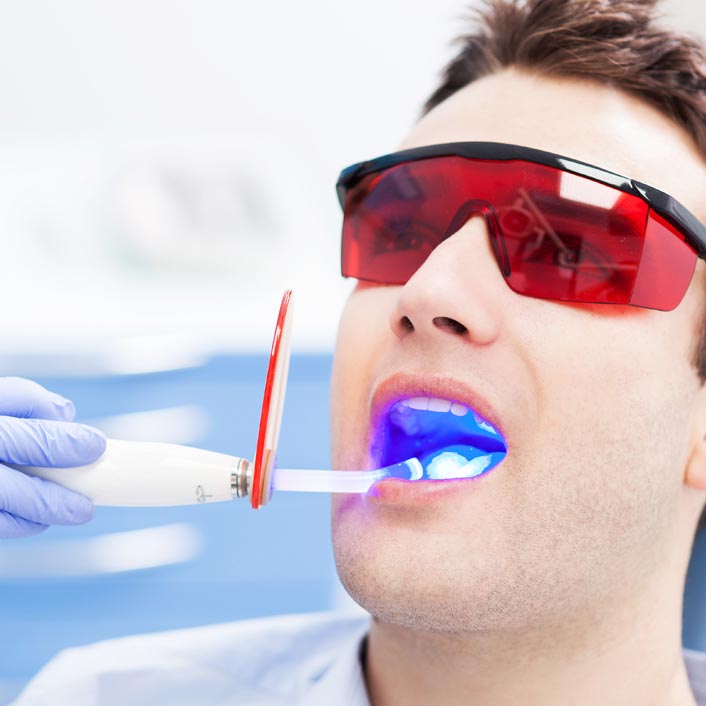
back
DIAGNOdent
Providing the absolute best service to our patients is of the highest importance to our office. To aid in achieving this goal, we use a new high-tech device called the DIAGNOdent. This small tool is a portable laser that allows us to detect cavities on the chewing surface of the back teeth that would have otherwise gone undetected by previous methods. Diagnosing cavities in the back of the mouth using traditional methods is difficult; studies even show that 50% of cavities are left undetected in these areas. However, the new DIAGNOdent enables us to locate and treat these cavities, putting a stop to further decay. The laser is easy to use, harmless, and will alert us with an audible signal if it detects a cavity. It will even calculate the approximate size of the cavity so we can better plan treatment. By using this device, you can rest assured that cavities will be accurately detected and treated in their infancy.
